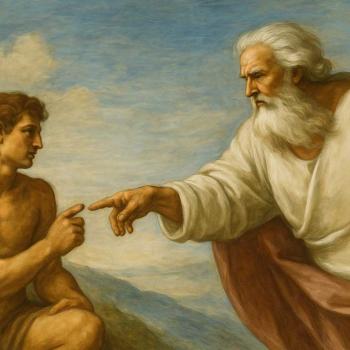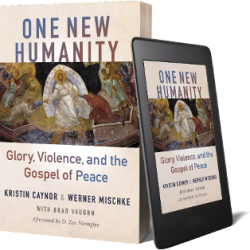Jesus' declaration that he is the "light of the world" (Jn. 8:12) should be read in the context of these towering blazing lights in the temple.
Based on several prophecies in the Hebrew Bible (Zech. 14:16-19; Is. 2:2-4, 56:6-8), by the time of Jesus the Feast of Sukkot had also taken on an eschatological aspect for many Jews, who believed that it would be the eschatological time for the ingathering of all the nations to worship YHWH at the temple of Jerusalem. This eschatological hope is reflected in Revelation 7:1-17, and forms the background to John's description of the revelation of Jesus as Messiah at the temple during the festival of Sukkot (Jn. 7-10). The concept of Sukkot as an eschatological harvest festival when the crops were gathered and the Lord's portion brought to the temple is also probably associated with the harvest allegories in the New Testament (Jn. 4:35; see also Mt. 9:37-38, 13:30; Mk. 4:29; Lk. 10:2).
Jesus' Authority (7:10-24)
As the Jewish pilgrims from around the world gathered in Jerusalem to celebrate the Passover, Jesus became a topic of conversation, some supporting him as a "good man" while others saying he is "leading the people astray" (7:12). This criticism is probably an allusion to Deuteronomy 13:1-11, where a prophet who "gives you a sign or a wonder" but leads people away from God must be stoned. It was thus a very serious accusation.
When Jesus began teaching publicly in the temple, he immediately gathered a large crowd of listeners, some sympathetic, some critical. The first reaction described by John is that they ask, "How does this man have learning (grammata, literally, "letters"), even though he has never studied (memathēkōs)?" (7:15). The claim here is not that Jesus is illiterate, but that he has never studied with an recognized rabbi, and yet speaks as if he were extraordinarily learned. In its historical context this accusation is that Jesus had not studied with a rabbi authorized by the Jewish establishment of the day, and failed to cite proper rabbinical authority for his teachings. Here is how the rabbinic tradition saw this type of situation:
If anyone has learned the Scripture and the Mishnah but has not served as a student of the Learned [rabbis] he is one of the 'people of the land' [commoners]. If he is learned in the Scripture but not the Mishnah he is an uneducated man. (Talmud, Sota 22a)
Thus, to be considered grammata-learned required that not merely that you knew how to read the scriptures, but that you had studied with an authorized rabbinic teacher. (See Acts 4:13 where Peter and John are likewise called agrammatoi, "unlettered" or "unlearned.")
To understand this situation we need to recognize the importance of the citation of authorities in Judaism in the first century. Like today, there were many differing competing sects and interpretations in first century Judaism. All accepted the authority of the Hebrew Bible, but each group interpreted scripture differently, thus creating the paradox of a single inspired authoritative text that somehow was unable to produce a consensus as to its meaning. Some branches of Judaism—especially the Pharisees—maintained that an authoritative oral tradition explaining the Bible had been passed down from Moses to the first century rabbis.
Moses received Torah from Sinai and delivered it to Joshua, and Joshua to the Elders, and the Elders to the Prophets, and the Prophets delivered it to the Men of the Great Synagogue [the Rabbis]. (Pirqei Abot 1.1 = Mishnah, Abot 1.1)
When Paul, a Pharisee convert to Christianity, proudly declared that he was "educated at the feet of Gamaliel according to the strict manner of the law of our fathers" (Acts 22:3, 5:34) he is talking about his rabbinic master in the Oral Law, just as rabbinic education required. Paul had such a rabbinic master. Jesus did not.
So, when a first century rabbi interpreted the Law, he did not simply give his opinion or interpretation. Rather, he recited a chain of authorities to support his teachings as the proper interpretation of the Law—"Rabbi X taught Rabbi Y, who taught Rabbi Z, who taught me." This practice appears throughout early rabbinic literature like the Mishnah, Tosefta, and Talmud. It was intended to guarantee the authority and legitimacy of a particular teaching or interpretation.
When Jesus is said to have "taught them as one who had authority, not as the scribes" (Mk. 1:22; Mt. 7:29), it means he was not citing rabbinic authorities for his teachings. Indeed, throughout the gospels Jesus never cites any rabbinic authority. Rather, he consistently begins his teachings, with the emphatic phrase, "Truly, truly, I say to you," (amēn amēn legō humin).
In fact, however, Jesus does cite an authority for his teachings, the highest possible authority, God the Father (Jn. 7.16-18, 8.28, 12.29, 14.10, 16.13). Jesus does not need to cite a rabbinic teacher because his teacher is the Father.
- "My teaching is not mine, but his who sent me. If anyone's will is to do God's will, he will know whether the teaching is from God or whether I am speaking on my own" (7:17).
- "I do nothing on my own, but speak just as the Father taught me" (8:28).
- "For I have not spoken on my own, but the Father who sent me has himself given me a commandment—what to say and what to speak" (12:49).
- "The words that I say to you I do not speak on my own, but the Father who dwells in me does his works" (14:10).





